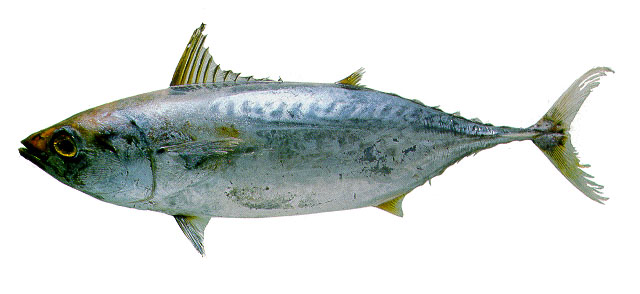| Scombridae (Mackerels, tunas, bonitos), subfamily: Scombrinae |
| 122 cm TL (male/unsexed); max.weight: 17 kg; max. reported age: 10 years |
|
reef-associated; depth range 1 - 150 m, oceanodromous |
| Atlantic Ocean: in tropical and subtropical waters, including the Mediterranean, Black Sea, Caribbean Sea and Gulf of Mexico. Highly migratory species, Annex I of the 1982 Convention on the Law of the Sea (Ref. 26139). |
|
Dorsal spines (total): 15-16; Dorsal soft rays (total): 11-13; Anal spines: 0-0; Anal soft rays: 11-15; Vertebrae: 39-39. Anterior spines of first dorsal fin much higher than the those mid-way, giving the fin a strongly concave outline. Interpelvic process small and bifid. Body naked except for corselet and lateral line. Swim bladder absent. Incipient protuberances on 33rd and 34th vertebrae. Back with broken oblique stripes (Ref. 168). Caudal peduncle with 7-8 finlets. Dark stripes on the back and with 3-7 dark spots between pelvic and pectoral fins (Ref. 35388). |
| Found in neritic waters close inshore (Ref. 13628). This schooling species is an opportunistic predator which feeds on virtually everything within its range, i.e. crustaceans, fishes (mainly clupeoid), squids, heteropods and tunicates. Eggs and larvae are pelagic (Ref. 6769). Specialized traps (madragues) are used in Tunisia and Morocco. Diving bird flocks may indicate large schools (Ref. 9710). Utilized fresh, dried-salted, smoked, canned and frozen (Ref. 9987). A popular game fish (Ref. 9710). |
|
(Ref. 96402)
|
| reports of ciguatera poisoning |
|
Source and more info: www.fishbase.org. For personal, classroom, and other internal use only. Not for publication.
Page created by Jen, 05.08.02,
php script by kbanasihan 06/09/2010 ,
last modified by
dsantos, 20/08/10

